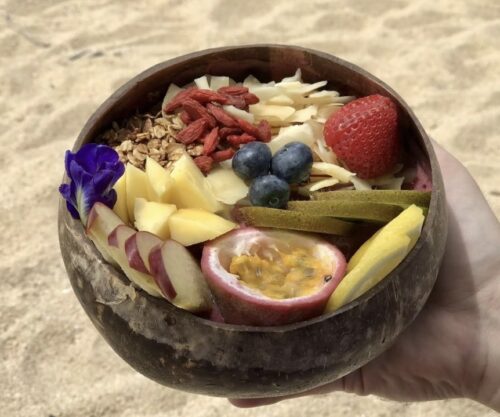
What’s really hiding in your favourite flavour-packed pantry staples – and what to look out for on the label.
Hidden names and sneaky ingredients
Flavour sachets and stock cubes are go-to pantry staples, perfect for quick dinners and comforting stews. But have you ever looked closely at what’s inside them? Along with salt and seasoning, many contain additives like MSG, sugar, and artificial flavour enhancers, often disguised behind unfamiliar names.
What actually is MSG?
MSG, or monosodium glutamate, is actually a naturally occurring flavour booster, glutamic acid. A type of amino acid found in a variety of foods, MSG is famous for giving dishes an ‘umami’ kick.
Japanese chemist Kikunae Ikeda discovered the flavour enhancer. He extracted glutamate from an umami-rich seaweed broth to produce the first man-made form of MSG, way back in 1908. Today, MSG is produced by fermenting starch, sugar beets, sugar cane, or molasses into an odourless white crystalline powder that many people sprinkle onto foods, like table salt.
Adding MSG to foods intensifies and enhances umami flavours in soups, sauces, broths, marinades, sweets and more. On its own, MSG is odourless and flavourless. The magic happens when it’s paired with ingredients, making it a popular additive for restaurants, food companies, and even home cooks.
Is MSG bad?
Many people are still divided over the use of MSG. While the consensus recognises MSG as generally safe, food manufacturers and companies are required to list MSG on the ingredients panel. However, about 2% of the population can have adverse effects when consuming it, such as:
- Experiencing headaches
- Feeling numb or tingling
- Potential weight gain or obesity
- Hyperactive behaviours (like ADD and ADHD)
- Flushing
- Heart palpitations
- Nausea
- Muscle aches
There might not be one clear smoking gun proving MSG is bad or harmful, but it is worth noting that eating anything in excess usually leads to adverse effects. It’s great to sprinkle over foods to add extra flavour, but keep it small and eat processed foods containing MSG in moderation.
MSG pseudonyms: How It Hides in Labels
MSG isn’t always listed as it is on labels. Other names for MSG include:
- glutamic acid
- hydrolysed vegetable protein
- yeast extract
- E621
- sodium caseinate
- ‘flavour’ or ‘flavouring’
- ‘seasonings’
- ‘broth’
- ‘natural flavour’
Here’s a list of foods and products, with terms, that contain hidden MSG. Next time you buy one, read the ingredients list to identify any hidden MSG. Look out for the following terms when choosing these products:
- Flavoured snacks: savoury, addictive, yeast extract, natural flavours
- Processed meats: flavour-enhancer, preserved, hydrolysed proteins, seasonings
- Fast foods: flavour-rich, consistent
- Soups and broths: Depth-enhanced, convenient, broth, flavouring
- Seasoning blends and spices: bold, flavourful, spices, garlic powder, hydrolysed vegetable protein
More than MSG, what else has been added?
Other than MSG, flavour sachets and stock cubes might have other food substances you might want to be aware of:
- Sugars and sweeteners: Look out for added sugars like corn syrup, cane sugar, maltose and dextrose, to sweeteners like aspartame, sucralose, and stevia. Many people may be allergic to the latter, not to mention the adverse effects high sugar intake has on the body.
- Hydrogenated oils: These are liquid fats processed into a solid form using hydrogen. Fully hydrogenated oils are saturated fats, while partially hydrogenated oils can contain harmful trans fats.
- Maltodextrin: A highly processed starch-derived carbohydrate used as a thickener or filler.
- Emulsifiers: Keeping oil and water components from separating in processed and packaged foods (like salad dressings and chocolate). Look out for lecithin, monoglycerides, and polysorbates on ingredient lists. Although generally safe, many emulsifiers contain trans fats, traces of modified soy, and other industrially manufactured ingredients that can cause inflammation.
- Thickeners: Used to alter texture and shelf-life. Look for: guar gum, xanthan gum, carrageenan — all of which may cause bloating or gut irritation in some people.
- Artificial colourants: Like FD&C Green No. 3 and Citrus Red No. 2. Some artificial colourants can cause serious illness, like cancer, and have been petitioned to be banned, like FD&C Red No. 3.
- Preservatives: From simple vinegar or salt to complex chemical agents like sodium benzoate, BHT, and nitrites. Some preservatives have been linked to endocrine disruption or cancer in animal studies, though more human research is needed.
Are all flavour sachets and stock cubes bad?
Not all flavour sachets and stock cubes are created equal. Some are packed with unnecessary additives and processed sugars, while others use fewer, cleaner ingredients. The key is in moderation and in reading the label. Even small changes in your pantry habits can make a big difference over time.
Before you reach for that flavour sachet, take a moment to check the label. With a little awareness, you can still enjoy bold, delicious meals without the hidden additives.
Compiled by: Annemieke van Nieuwkerk
First published on Food & Home




